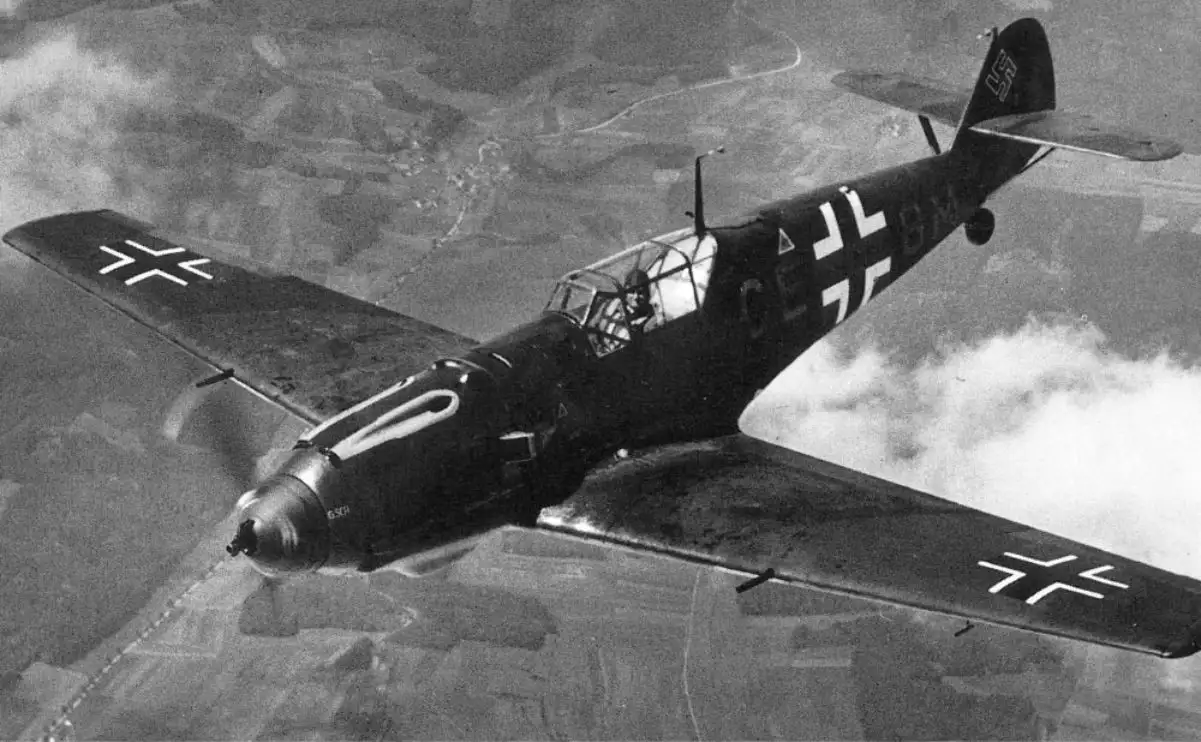One of the most advanced aerodynamic designs of the 1930s
The Messerschmitt Bf 109 began as an entry by the Bayerische Flugzeugwerke in a Luftwaffe (German Air Force) fighter competition in the early 1930s. With retractable landing gear, an enclosed cockpit, automatic slats, cantilever wings, and stressed skin construction, Willy Messerschmitt’s design featured some of the most advanced aerodynamic designs at the time. The Bf 109 performed noticeably better during the trials than the heavier and larger favorite, Heinkel’s He 112. In 1936, the Bf 109B, the first production model, started to leave the assembly line. The redesignation of the Bayerische Flugzeugwerke AG (Aktiengesellschaft or Corporation) to the Messerschmitt AG in 1938 led many to call it the Me 109. However, the official Luftwaffe designation of the aircraft remained the Bf 109 throughout the war.
The Bf 109B first entered combat with German-manned Condor Legion units during the Spanish Civil War, and they were a welcome replacement for the obsolete Heinkel He 51 biplane fighter. The Bf 109C, introduced in 1938, retained the twin 7.9mm MG 17 machine guns mounted above the engine but replaced the single MG 17 firing through the propeller spinner with two MG 17s in the wings.

The Bf 109E went into production with the Daimler Benz DB 601 in early 1939, following the construction of less than 200 Bf 109Ds. The Bf 109E completely outclassed the Polish PZL fighters in the early stages of World War II. The Bf 109E outfought British Hawker Hurricanes and French Morane-Saulnier MS 406s in the May 1940 invasion of France.
In the air battles over the English Channel and later during the Battle of Britain, the Bf 109E exposed its Achilles heel—its short range—and met its equal, the Supermarine Spitfire.
Bf 109 Vs Spitfire
According to Neil Page’s explanation in Luftwaffe Fighters: Combat on all Fronts Volume 1, aileron heaviness significantly reduced the Messerschmitt Bf 109’s and the Spitfire’s ability to roll at high speeds.
The following information on the Bf 109 E is taken from the Ministry of Supply’s Messerschmitt Bf 109 Handling and Manoeuvrability Tests, a British test document. September 1940: “More detailed aileron tests (measurement of stick forces and time to bank) were made. These tests showed that although the Bf 109 ailerons felt much heavier than those of the Spitfire at speeds between 300mph (483km/h) and 400mph (644km/h), the a/c could be made to bank at about the same rate as the Spitfire at these high speeds.
“The more ‘solid’ feel of the Bf 109 ailerons at high airspeeds is attributed to the smaller stick travel (+/- 4in compared to +/- 8in on the Spitfire), fairly rigid control circuit, and partly to the awkward seating position of the pilot… at 400mph (644km/h) the Bf 109 pilot, pushing sideways with all his strength, can only apply about 1/5 aileron, thereby banking 45 deg. in about 4 secs.; on the Spitfire also, only 1/5 aileron can be applied at 400mph, and again the time to 45 deg. bank is about 4 secs…”
Turning more readily to the right than to the left
The Spitfire’s ailerons did not feel as ‘solid” at 400mph as those of the Bf 109; this was because there was rather more ‘stretch’ in the aileron control circuit of the Spitfire. The maximum sideways force a pilot could exert on the stick worked out at around 60lb on the Spitfire, but only about 40lb on the Bf 109. The reason for this difference was that the cockpit of the Bf 109 was so cramped that a pilot could not bring his arm round into the position most favorable for applying a large side force to the stick. And it was not only the ailerons that caused problems for the 109 pilot.
The following is again from the Ministry of Supply September 1940 test report: ‘It is at high speeds that lack of a rudder trimmer most seriously inconveniences the pilot. At 215mph (346km/h), the a/c is trimmed directionally, no rudder being required. At higher speeds left rudder must be applied, and at 300 mph (483 km/h), about 2 deg. of left rudder are needed. The rudder is very heavy at high speeds, and a large force is required to apply even such a small amount. This becomes very tiring and affects the pilot’s ability to put on more left rudder to assist a turn to the left. Consequently, at high speeds, the Bf 109 turns more readily to the right than to the left.”
Luftwaffe Fighters: Combat on all Fronts Volume 1 is published by Mortons Books and is available to order here.

